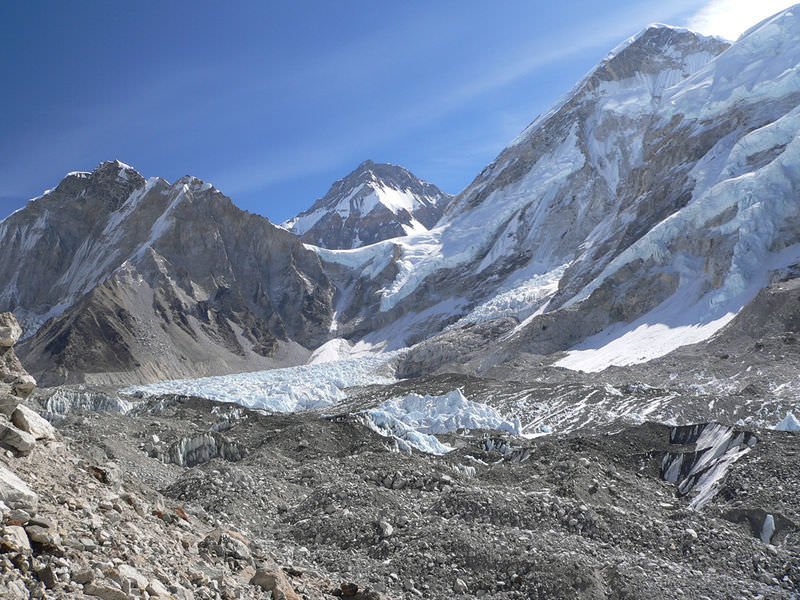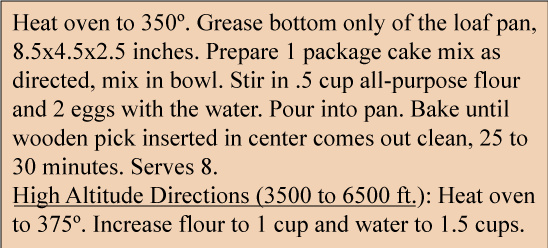2.14 气体
章节大纲
-
A hiker pauses to view the impressive peak of Mount Everest, the tallest mountain in the world. At the top of Mount Everest, the air is very thin. Climbers may need oxygen tanks to get enough oxygen to breathe, even though oxygen is the second most plentiful gas in the atmosphere.
::登山者停下来观看珠穆朗玛峰这一令人印象深刻的山峰,这是世界上最高的山峰。 在珠穆朗玛峰顶端,空气非常薄。 登山者可能需要氧气罐来获得足够的氧气呼吸,尽管氧气是大气中第二多的气体。What Is a Gas?
::什么是气体?A gas is one of four well-known . (The other three are , , and plasma). The particles of a gas can pull apart from each other and spread out. As a result, a gas does not have a fixed shape or a fixed volume . In fact, a gas always spreads out to take up whatever space is available to it. If a gas is enclosed in a container, it spreads out until it has the same volume as the container.
::气体是四个众所周知的气体之一。 (另外三个是, 和等离子体)。气体的颗粒可以相互分离,扩散出去。因此,气体没有固定的形状或固定的体积。事实上,气体总是扩散出去,以占用它所拥有的空间。如果气体被封闭在容器中,它就会扩散出去,直到它与容器的体积相同。Q: The sketches in the Figure represent two identical sealed boxes that contain only air particles (represented by dots). There are more air particles in box B than box A. Which box contains a greater volume of air?
::问题:图中的草图代表两个相同的密封盒,其中只含有空气颗粒(用点表示)。B框中的空气颗粒多于A框。哪个框含有更大的空气量?A: This is a trick question! The air inside each box expands to fill the available space, which is identical for both boxes. There are more air particles in box B, but the volume of air is exactly the same in both boxes.
::A: 这是一个诡计问题 ! 每个框中的空气会膨胀, 以填充可用空间, 这对两个框都是相同的 。 B 框中有更多的空气颗粒, 但两个框中的空气量完全相同 。Pressure of Gases
::气体压力Particles of gas are constantly moving in all directions at random. As a result, they are always bumping into each other and other things. This is modeled in the Figure . The force of the particles against things they bump into creates pressure . Pressure is defined in physics as the amount of force pushing against a given area. How much pressure a gas exerts depends on the number of gas particles in a given space and how fast they are moving. The more gas particles there are and the faster they are moving, the greater the pressure they create.
::气体粒子不断随机地向各个方向移动。 结果, 它们总是相撞。 这是在图中建模的。 粒子对它们遇到的事物的威力会产生压力。 物理学将压力定义为对特定区域施加的威力。 气体施压有多大的压力取决于特定空间的气体粒子数量和它们移动的速度。 气体粒子越多,它们移动越快,它们产生的压力就越大。The arrows show that particles of a gas move randomly in all directions. Q: Look at box A and box B in the previous question. Is air pressure the same in both boxes? Why or why not?
::问题:在前一个问题中,请看框A和框B。两个框中的气压是否相同?为什么或为什么没有?A: Air pressure is greater in box B. That’s because there are more air particles in box B to bump into each other and into the sides of the container. Therefore, the particles in box B exert more force on a given area.
::A:B框中的空气压力更大。 这是因为B框中有更多的空气粒子互相碰撞并进入容器的侧面。 因此,B框中的粒子对特定区域产生更大的压力。Pressure in the Atmosphere
::大气中的压力We live in a “sea” of air called the atmosphere. Can you feel the air in the atmosphere pressing against you? Not usually, but air actually exerts a lot of pressure because there’s so much of it. The atmosphere rises high above Earth’s surface, so it contains a huge number of gas particles. Most of them are concentrated close to Earth’s surface because of gravity and the of all the air in the atmosphere above them. As a result, air pressure is greatest at sea level and drops rapidly as you go higher in altitude . The Figure shows how air pressure falls from sea level to the top of the atmosphere. In the graph, air pressure is measured in a unit called the millibar (mb). The SI unit of pressure is the pascal (Pa), equal to one newton per square centimeter (1 Pa = 1 N/m 2 ).
::我们生活在一个叫做大气的“海洋”的空气中。你能感觉到大气中的空气对你们造成压力吗?通常不是,但空气实际上施加了很大的压力,因为有如此多的气压。大气在地球表面高处上升,因此它含有大量的气体粒子。它们大多由于引力和上面大气中所有空气的重力而聚集在靠近地球表面的地方。因此,空气压力在海平面上最大,随着高度升高而迅速下降。图显示空气压力如何从海平面降到大气层顶部。在图中,空气压力用一个称为毫巴(毫巴)的单位测量。SI压力单位是帕斯卡尔(帕),相当于一牛顿厘米(1帕=1纳姆)。Q: The top of Mount Everest is almost 9 km above sea level. What is the pressure of the atmosphere at this altitude?
::问题:珠穆朗玛峰的顶部离海平面近9公里。这一高度的大气压力是什么?A: Air pressure at the top of Mount Everest is about 260 mb. This is only about 25 percent of air pressure at sea level, which is 1013.2 mb. No wonder it’s hard for climbers to breathe when they get close to Mount Everest’s summit!
::A:珠穆朗玛峰顶部的气压约为260毫升。这只占海平面气压的25%左右,即101.32毫升。 难怪登山者在接近珠穆朗玛峰峰顶峰时很难呼吸!Summary
::摘要-
Gas is a state of matter in which particles of matter can pull apart from each other and spread out. As a result, a gas does not have a fixed shape or a fixed volume.
::气体是一种物质粒子可以分离并扩散的物质状态。 因此,气体没有固定形状或固定体积。 -
Gas particles are constantly moving and bumping into things, and this creates force. The amount of force pushing against a given area is called pressure.
::气体粒子在不断移动和撞入事物中,这产生了力量。对特定区域推力的强度被称为压力。 -
The pressure of gases in the atmosphere is greatest at sea level and decreases rapidly as altitude increases.
::大气中的气体压力在海平面上最大,随着海拔升高而迅速减少。
Review
::回顾-
What is a gas?
::什么是气体? -
Why does a gas not have a fixed shape or a fixed volume?
::为什么气体没有固定形状或固定体积? -
Explain why a gas exerts force
::解释为什么燃气会施加武力 -
What does pressure measure?
::压力衡量什么? -
Air pressure affects how high a cake rises when it bakes. Directions for cake mixes often have special high altitude instructions, like those on the label below. Explain why.
::空气压力会影响蛋糕烘烤时的升幅。 蛋糕混合方向通常有特殊的高海拔指令, 如以下标签上的指令。 请解释原因 。
Explore More
::探索更多Examine this sequence of photos in the Figure , and then answer the questions below.
::在图中检查这一系列照片,然后回答下面的问题。-
How does a balloon change as a child blows more air into it?
::气球如何改变 当一个孩子 吹更多的空气进入它? -
How does air cause this change in the balloon?
::空气如何造成气球的这种变化?
Resources
::资源 -
Gas is a state of matter in which particles of matter can pull apart from each other and spread out. As a result, a gas does not have a fixed shape or a fixed volume.





